Ruralite
ALASKA VILLAGE ELECTRIC COOPERATIVE FEBRUARY 2025

INSIDE >>
Fireplace Efficiency It’s Annual Meeting Time
Remote Areas Benefit From Digital Utility Payments











































ALASKA VILLAGE ELECTRIC COOPERATIVE FEBRUARY 2025

INSIDE >>
Fireplace Efficiency It’s Annual Meeting Time
Remote Areas Benefit From Digital Utility Payments










































February 2025 • Volume 72, No. 2
CEO Michael Shepard
SENIOR VP OF CONTENT Leon Espinoza
EDITORIAL DIRECTOR Chasity Anderson, CCC
DEPUTY EDITORIAL DIRECTOR
Noble Sprayberry
SENIOR EDITOR Jennifer Paton, CCC
ASSISTANT EDITORS Victoria Hampton, CCC; David Herder, CCC; Sable Riley, CCC
ASSOCIATE EDITORS
Valeri Saldanha Rosa, Nina Todea
PUBLICATIONS PRODUCTION SR. MANAGER
Elizabeth Beatty
SENIOR PUBLICATIONS COORDINATOR
Alyssa McDougle
Ruralite (USPS 397-460) is published monthly for members for $5.43 per year, plus postage, by Pioneer Utility Resources Inc., 5625 NE Elam Young Pkwy. Ste. 100, Hillsboro, OR 97124—a not-for-profit Oregon cooperative corporation—to serve the communication needs of 46 consumer-owned electric utilities in Oregon, Washington, Alaska, Idaho, Nevada and California. Preferred periodical postage paid at Hillsboro, Oregon, 97123 and additional mailing offices. © 2025 Pioneer Utility Resources. All rights reserved. Reproduction in whole or in part without written permission is prohibited.
Postmaster: Send address changes to Ruralite, 5625 NE Elam Young Pkwy. Ste. 100, Hillsboro, OR 97124-6454
HOW TO CONTACT RURALITE
Subscription services:
Nonmember subscriptions $15 (U.S.) per year; $25 per year (foreign). Prepayment required. Allow 4-8 weeks for first issue. Be sure to identify which local edition you want to receive.
Address Changes:
Utility members, contact your local utility. Subscribers, call us at 503-357-2105 option 3 or email mailingdept@pioneer.coop.
Back issues:
Back issues and extra copies $3. Prepayment required. Supply is limited. Be sure to identify edition, month and year. Call first if ordering back issues to check availability.
To contact Ruralite: Ruralite magazine is published by Pioneer Utility Resources.
P.O. Box 1306, North Plains, OR 97133-1306; 503-357-2105; email: info@pioneer.coop. For more information, visit www.pioneer.coop.
DISPLAY ADVERTISING INQUIRIES
American MainStreet Publications
611 S. Congress Ave., Ste. 504 Austin, TX 78704
800-626-1181 or 512-441-5200
February always has a chill to the air, but it’s also a month brimming with warmth and connection.
As we lean into the spirit of Valentine’s Day, our stories reflect the love and care that bind our communities together— from the joy of making music to the dedication of those nurturing the land and each other.
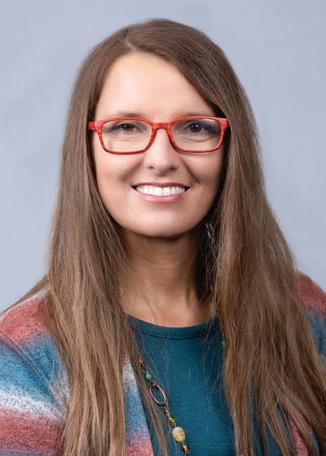
In a small, historic schoolhouse near Junction City, Oregon, the lively strains of fiddle music fill the air. Thanks to music teacher Amy Burrow, young musicians are discovering the joy of traditional jam sessions.
Amy’s quarterly gatherings, supported by grants, are more than just lessons. They are opportunities to build confidence, creativity and camaraderie. For 14-year-old Sapphire Rain, fiddle music is all about freedom and expression.
“You can do what you want with it,” she says.
What better way to share the love of music than by passing it on to the next generation? You can read more on Page 10.
The idea of sharing knowledge and building connections extends to our feature on University Extension programs. Across the country, these programs empower individuals and strengthen communities.

From helping women in farming gain confidence through Annie’s Project in Idaho to saving lives through the Diabetes Prevention Program in Arizona, Extension offices focus on uplifting people in practical, meaningful ways. Read more on Page 12.
February is a time to embrace moments of connection. Whether it’s a warm meal shared with loved ones, planning a spring garden with a friend or learning something new and sharing that new skill, this month invites us to celebrate the ties that bind us.

Have an idea for a story we should share about your community? Reach me at editor@pioneer.coop.
Chasity Anderson Editorial Director

For supplemental and interactive content, search @Ruralite on your favorite social media sites.
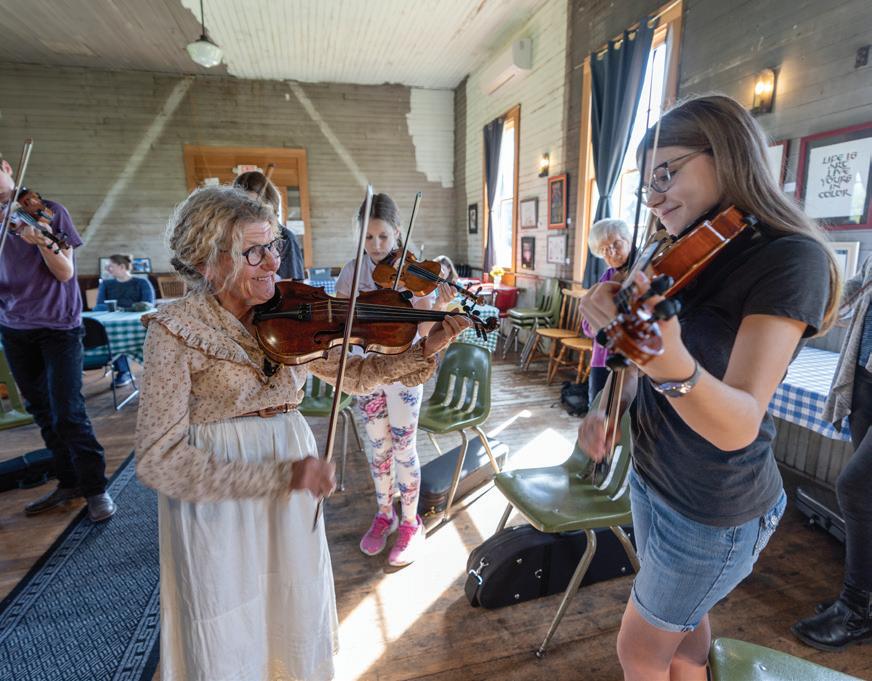
Up Close, Page 10
From hands-on farming skills to diabetes prevention, initiatives help America innovate
Spotlight, Page 12
In The Kitchen, Page 16
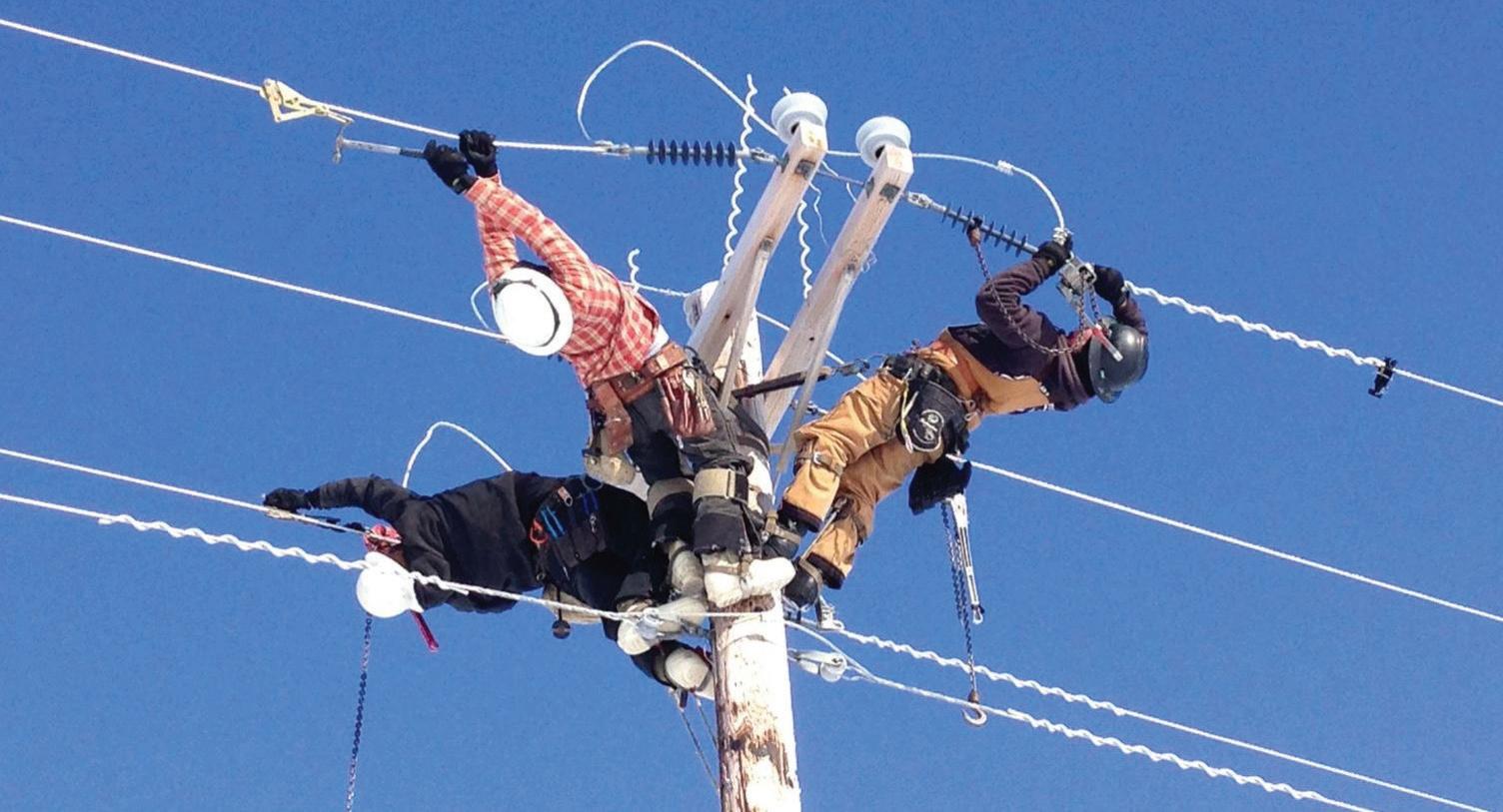
By Stacey Smith
With harsh weather often resulting in lost or delayed mail, Alaska Village Electric Cooperative’s digital payment system has transformed how its members access and pay bills.
Alaska may not be the first place that comes to mind when people think about the bleeding edge of digital transformation, and that is with good reason. The state historically has struggled to keep up with the Lower 48 when it comes to technological innovations, largely due to Alaska’s unique geography, vast size and low population density. These factors pose significant challenges to building the infrastructure needed for mass digitization. This lack of basic infrastructure extends to all forms of digital services, from basic cellphone coverage and online education to telehealth and digital billing and payments.
However, these challenges are not insurmountable. With the right strategic planning and implementation, Alaskan service providers can overcome these obstacles and propel themselves into the digital age, offering their communities the daily conveniences of technology and solutions to challenges that are unique to their lifestyles.
Addressing this lack of connectivity is a primary objective for AVEC, providing service to 59 Alaskan villages and spanning the largest area of any electric power cooperative in the world. Only one of the 59 villages is connected by the road system, while the other 58
are so remote they can only be reached by boat or plane.
Given the challenging environment—which varies between mountainous regions, sprawling forests and icy tundras—one might think an electric utility upgrade would involve installing new cables or circuit boards. While AVEC is continually problem-solving for its physical infrastructure, the biggest game changer for the utility’s member services team has been overhauling the digital payments system and providing customers new options to access invoices and pay bills online.
Before June 2021, AVEC had seven customers enrolled in its automatic payment option, and it did not offer any options for paperless billing. These inadequacies would be a frustration in any environment, but for the remote villages AVEC serves, they amounted to much more than a simple inconvenience.
Many people in these communities live subsistence lifestyles, meaning they depend on fishing, hunting and gathering to feed their families. That means they rely heavily on freezers to store enough meat and fish to last several months. While most people would be annoyed by a suspension in service due to a missed utility payment, for these Alaskans, the risk of having their electricity turned off is enormously consequential.
This challenge is further compounded by the fact that delinquent
payments are common among AVEC customers and not always through any fault of their own. Mail delivery to remote villages is unpredictable at best: Harsh weather can prevent planes from landing for weeks at a time, and logistical challenges mean lost or delayed mail and parcels are common.
AVEC customers in the remote villages report receiving bills late and payments getting lost in the mail. When a delinquent payment leads to an electricity shutoff, the consequences of such unreliability are severe. Families relying on subsistence hunting and fishing risk having months’ worth of food go bad.
Something had to change. For AVEC, finding a digital solution to the billing issues was not just about convenience. It was about safeguarding the stability and well-being of its member communities and ensuring their way of life continues to be possible. It also was clear the member needs were as unique as they were considerable. To be successful, the digital payments solution had to be robust and flexible, not to mention easy to use for a variety of comfort levels with technology.
To address these challenges, AVEC took a multipronged approach. The utility invested in upgrading communications to satellite coverage for reliability and then focused on its billing system by forging partnerships with financial institutions and technology providers. Simultaneously, it conducted a comprehensive community outreach and education campaign to encourage adoption.
The utility expected to invest considerable time and resources encouraging adoption of the new system, but word spread fast because the program’s benefit was self-evident. Nearly as soon as AVEC went live with its billing partner, InvoiceCloud, its customers enrolled in paperless billing in droves.
Today, AVEC has more than 6,500 paperless billpayers. As for automatic payment, the utility increased from seven people participating in the program to 1,755—a 24,971% leap forward.
One factor AVEC’s member services team believes contributed to the utility’s success with InvoiceCloud was how it communicated the new payment option. The team did not just communicate it was a new billing system but also a way to protect member interests and the community’s well-being. For residents who were accustomed to receiving bills late or worrying about lost payments, the ability to pay bills online or automatically was not just a matter of convenience but a crucial way to ensure their families’ safety and stability.
The difference has been nothing short of transformational. AVEC is saving more than $20,000 per month on invoicing alone since going live with its digital billing upgrade.
However, the real reward has been the impact on the community. AVEC members who had been at the mercy of the postal system— which itself is at the mercy of the weather—were no longer burdened with the anxiety of not knowing whether their power would be shut off due to a delinquent payment they knew they had made.
The psychological and emotional relief for members cannot be understated. The adoption of digital payments provided them with peace of mind and a sense of control over their essential
utilities. This transformation also helped AVEC to build stronger relationships with its customers, who now see the utility not as a service provider but as a partner in their daily lives who works to improve their quality of life.
Alaska is not unique in facing these challenges. Across the world, remote communities struggle with similar issues: a lack of infrastructure, challenging environments and a need for reliable services. AVEC’s experience shows digital transformation can be a powerful tool for these communities. It is not just about keeping up with the times or adopting the latest technology trends; it is about creating a meaningful impact and ensuring customers can continue living their lives the way they choose.
Advancements in technology are appealing to every business. No matter the industry, seamless, straightforward tools that contribute to the bottom line are valuable assets and worth investing in. AVEC found thoughtful technology implementation can actually help to preserve heritage by supporting traditional ways of life. Ironically, by embracing digital innovation, the utility has helped Alaskans embrace their heritage and not only survive but thrive.
Many of AVEC’s customers live lifestyles that have been handed down for generations—hunting, fishing and foraging for their food. The ability to keep their freezers running reliably and their homes warm is crucial to maintaining these traditional ways of life. The utility’s digital payment solution helps to protect this heritage by eliminating some of the risks that come with unpredictable billing cycles and unreliable postal services.
AVEC’s digital payment revolution is more than just a statistical success; it is an investment in Alaska’s future and its history. The utility has demonstrated digital transformation can be a game changer even in the most remote and logistically challenging environments.
For other rural communities facing similar barriers, AVEC’s story can serve as an example that sometimes technology is more than a convenience. By prioritizing digital bill payment solutions, the utility modernized its technology tools and enhanced members’ quality of life.
AVEC’s member services team encourages other utilities and service providers to take a page from AVEC’s book and harness the power of technology to create meaningful, lasting impact: invest in digital upgrades, collaborate with local communities and transform challenges into opportunities for growth and resilience. The future is digital, and it is time for all rural communities to seize it.
As AVEC looks to the future, it remains committed to finding new ways to leverage technology to benefit its members. The digital payment platform is just the beginning. The utility is exploring other avenues of innovation that could further enhance service reliability, reduce costs and improve the quality of life for those it serves. From smart grid technologies to renewable energy solutions, the possibilities are extensive.
With its vast landscapes and resilient communities, Alaska might not have been the first place one would think of for digital innovation. But perhaps, in this land of extremes, it is precisely where innovation matters most. n
Increasing need for power affects electric utilities and their consumers
By Scott Flood
When rural electric utilities first strung power lines from farm to farm, across waterways and through remote forests less than a century ago, most consumers had but a handful of light bulbs to power. With time, they added appliances like refrigerators, but they surely couldn’t imagine the number and variety of electrical devices in today’s homes and garages.
Across the United States, consumers use a growing amount of electricity at work, at home and, with the growth of electric vehicles, on the road.
The demand for electricity increased by 2.5% in 2024 and is expected to grow by 3.2% this year. This comes after many utilities saw a 4.8% increase in 2022. Through 2029, the nation’s peak demand is projected to grow by 38 gigawatts. That would be like adding another Californiasized state to our nation’s power grid.
Driving this surge are advancements in technology, including artificial intelligence, cryptocurrency and cloud computing, which rely on energy-intensive data centers. These facilities, often located in rural areas due to affordable land and fewer neighbors, require massive amounts of electricity.
According to the U.S. Department of
Energy, data centers consume up to 50 times more energy per square foot than traditional commercial buildings. By 2030, these centers are expected to account for 9% of the nation’s electricity use, up from nearly 2% today. A single large data center may demand more than 100 megawatts of power, enough to supply 80,000 homes.
At the same time, baseload power—the always-available energy typically generated by coal and nuclear plants—is being retired at a rapid pace. More than 110 gigawatts of this reliable power are slated to disappear by 2033. As renewable energy sources like solar and wind grow, they cannot fully replace baseload generation due to their intermittent nature. Without sufficient baseload power, the risk of rolling brownouts and blackouts increases, a scenario experts warn could affect 19 states by 2028.
This growth in demand is unprecedented. A decade ago, a huge commercial project might boost a utility’s total load by 20 or 30 megawatts.
“Now, they’re getting requests for projects in the hundreds of megawatts,” says Stephanie Crawford, regulatory affairs director for the National Rural Electric Cooperative Association.
This growth places immense pressure to expand capacity and upgrade infrastructure.
To address these challenges, the efforts fall into two categories: increasing knowledge and building relationships. A generation ago, power supply discussions were fairly straightforward for utility directors, given the widespread availability of baseload generation. Today’s directors increasingly find themselves learning about
sophisticated and challenging issues as they weigh decisions affecting operations and financial viability for years to come.
They must grapple with complex energy issues, from ensuring sufficient transmission capacity to understanding regulatory hurdles. Supply chain constraints also pose significant barriers, with delays for critical components like transformers stretching up to two years.
Relationship-building is equally crucial. Utilities must engage early and often with companies planning large energy projects to ensure alignment on costs, timelines and infrastructure needs. For instance, phased development of a data center can give them more time to prepare for peak loads. Partnerships to develop on-site generation assets may also alleviate transmission challenges.
While these tech companies are often willing to invest in infrastructure upgrades, their focus is on reliability rather than cost. Utilities must balance these demands with their obligation to maintain affordability and reliability for all consumers.
In addition to preparing for new projects, Stephanie notes the importance of leaders keeping their fingers on the pulse of their existing commercial accounts.
“Being proactive and reaching out to understand how a commercial account’s energy needs may be changing in the coming years will inform conversations and decisions about timing, rate design and other factors, even if they’re not making specific requests yet,” she says.
Stephanie says this improved communication helps utilities serve emerging needs while protecting reliability for all consumers. n
After decades of flat or declining electricity demand, the United States is in the midst of a boom in power use. Recent government data shows power consumption nationwide is set to increase by at least 38 gigawatts between now and 2029. This trend would ordinarily be great news for the power industry. But government policies aimed at shutting down fossil fuel-based generation and yearslong delays in permitting and siting for new transmission lines are turning this power boon into a capacity crisis. Here are the primary demand drivers:
Electrification
Electric vehicle adoption, electrification of home heating and industrial electrification are expected to increase overall U.S. energy consumption by 1% per year through 2026.
Driven by explosions in artificial intelligence, cryptocurrency and cloud computing, total U.S. data center load is projected to increase by 65% by 2050.
Residential power consumption is expected to increase by 14% to 22% through 2050 due to increases in population and steady economic growth.
New, expanding and “onshored/reshored” manufacturing capacity driven by federal incentives is expected to increase industrial demand by 13,000 GWh per year. Key products: EVs, batteries, semiconductors, solar power components
Analysts predicted in 2023 that U.S. peak demand will increase by at least 38 GW over the next five years, nearly double the growth rate predicted in 2022.
PHOTO BY MARK GILLILAND
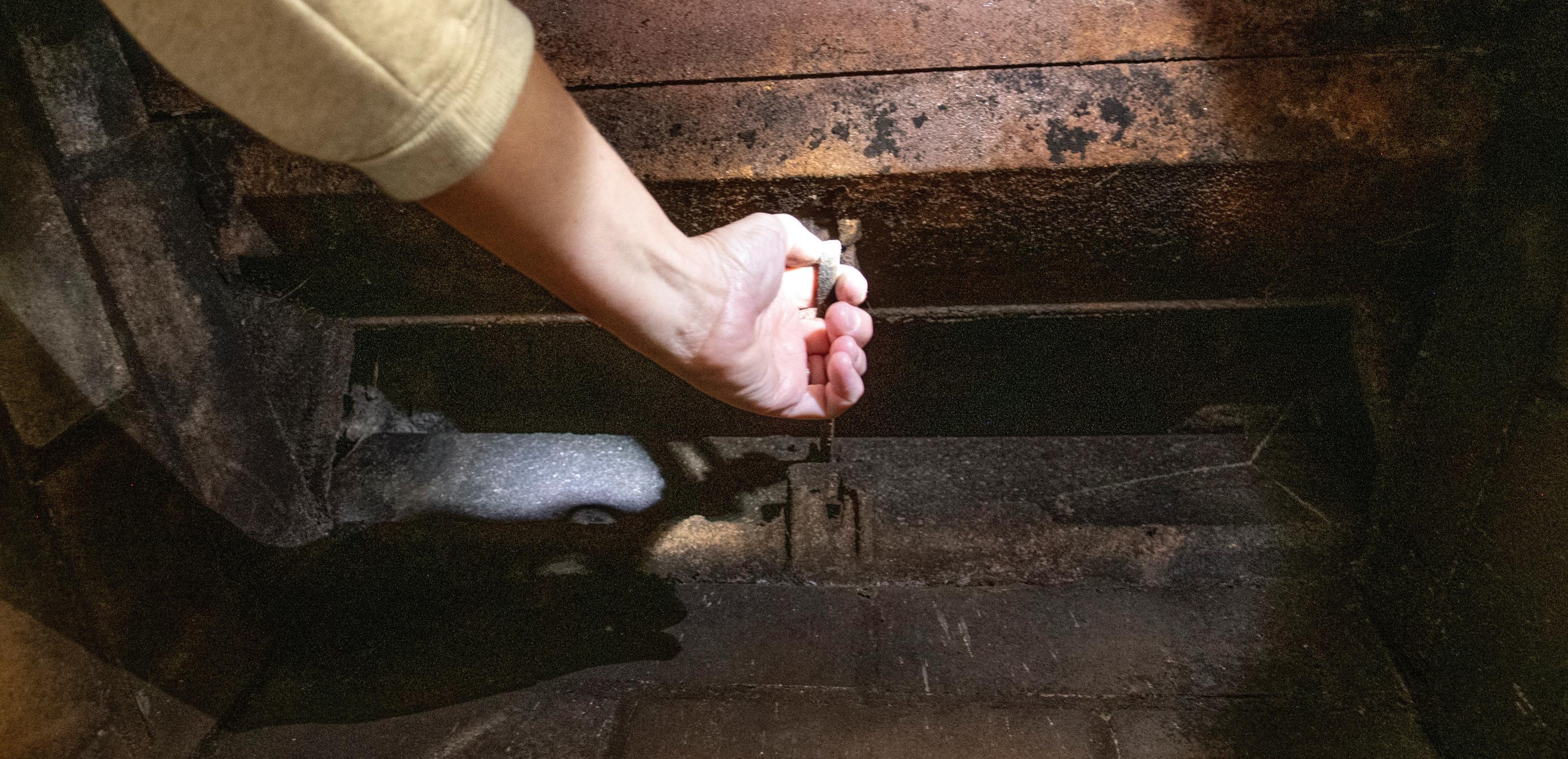
By Miranda Boutelle
Q: I heard fireplaces make your home colder. How do I keep my home comfortable while enjoying cozy fires?
A: When I was a little girl growing up in North Carolina, I remember my dad telling me that some nights were too cold to have a fire. That always seemed crazy to me, but like many other things he said, he was right.
A heat pump heated our home. We had an open fireplace that was more suited for ambiance than creating heat. When you have a fire, warm air rises and draws the smoke out through the chimney. This also draws the warm air out of the house. This invisible force is called the stack effect.
The impact is exacerbated in drafty homes. When warm air escapes through the chimney, it is replaced by cool air leaking in through gaps and cracks in the home. The greater the difference between the indoor and outdoor temperatures, the greater the stack effect, hence Dad’s rule of no fires on the coldest nights.
Wood fireplaces are not efficient at heating homes. Most of the heat leaves through the chimney. If you enjoy the ambiance and curling up in front of the fireplace during colder months, here are some tips to efficiently operate a fireplace in your home.
Because it’s out of sight, it can be easy to forget to close the chimney damper. The damper should be open when you have a fire going or when hot ashes are in the fireplace to ensure smoke and carbon monoxide don’t come into your home.
Once the fire and ashes are fully extinguished, close the damper. Leaving the damper open allows warm air to escape, wasting energy. It’s like leaving a window open when your heating system is turned on in the winter.
If your damper doesn’t close properly or your chimney doesn’t have one, buy a product designed for the task. There are a variety of chimney plugs, including inflatable options designed to fit in place.
While you’re at the hardware store, pick up caulking and weatherstripping to seal air leaks around windows, doors and pipes along exterior walls.
Fireplaces with gas logs are required to be installed with a mechanism that keeps the damper open. This safety feature allows gases from the pilot light to escape. Glass doors can reduce the impact of air leakage. Consider installing glass doors on open fireplaces and keep them closed to minimize drafts.
Sealed-combustion gas fireplaces are fully enclosed systems that draw the air needed for combustion from the outside. When properly installed, you get the benefit of the warmth of the fire without worrying about heat loss from drafts.
If you have gas logs and enjoy the ease of a gas fireplace, consider upgrading to a sealed-combustion unit.
Turning the pilot light off in the summer can reduce wasted gas. If you plan to turn the pilot light off, follow the instructions in the owner’s manual to avoid any possible safety issues.
Woodstoves and pellet stoves also provide more heat than wood or gas fireplaces. Federal tax credits are available for high-efficiency biomass stoves. A credit of 30% of the project cost—including the cost of installation up to a maximum of $2,000—is available for products purchased and installed between Jan. 1, 2023, and Dec. 31, 2032. The unit must have a thermal efficiency rating of 75% or more. For more information, visit www.energystar.gov.
If you have a woodstove, fireplace or any fuel-burning appliance in your home, be sure to install and maintain smoke and carbon monoxide detectors. Carbon monoxide is an odorless, colorless gas that can be harmful or deadly if not detected.
Use my dad’s sage advice and these tips to keep your home warm while gathering your loved ones around a glowing fire this winter season. n
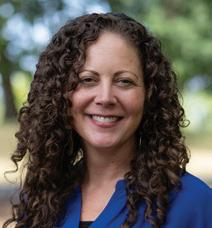


























American Gold Reserve is releasing Government issued $5 Gold American Eagles completely free of dealer mark-up for only $299 each. These beautiful $5 Gold American Eagles are a perfect way to enter the gold market. They are set for immediate public release and will sell out fast.










Story and photos by Mike Teegarden
The distinctive ring of fiddle music fills the small, one-room 1888 schoolhouse near Junction City, Oregon, as musicians tune up and prepare to jam.
But before an outburst of jigs and reels gets toes tapping, a few preliminary instructions from organizer Amy Burrow are in order because this is a jam session lesson.
Amy, a music teacher and fiddler from nearby Eugene, used grants to fund a quarterly jam session for students ages 8 to 18. Her goal is to teach the next generation of fiddlers how to participate successfully in a traditional jam session.
“What I want is that kind of language of knowing 50 to 100 tunes that they can go sit in on a jam almost anywhere in Oregon and call a tune with confidence,” Amy says. “Start it at a tempo that they can manage. Get everybody to play along and know how to finish it.”
The 21/2-hour lesson and jam includes learning new tunes and practicing the etiquette surrounding playing with a group.
Students learn “Dry and Dusty” and “The Snake River Reel.”
The tunes are taught by ear. Amy plays a phrase, and the fiddlers do their best to play it back to her. Once they have a section
down, Amy moves on to the next until the music reaches their fingers.
The real fun begins once notes are memorized. Now, the musicians are free to add their own flair to the tune. They may slide certain notes or add staccatos—quickly played notes—or use other fiddle techniques that add character to the music.
Sapphire Rain, 14, from Monmouth, Oregon, has played fiddle for about two years. She loves fiddle music because the structure allows her to experiment.
“It’s the freedom,” she says. “You can do what you want with it. I have always wanted to play fiddle since I was 4 or 5.”
Tristan Lulay, 15, from Scio, Oregon, loves the feeling of a large group playing together.
“When everyone is playing, it all comes together,” he says. “Even if everyone isn’t a great player.”
Old-time fiddle music is perfect for dancing, so students set down their instruments and pair up for a circle dance as the adult musicians play. The simple circle dance uses moves common to square dancing to mix and move the dancers around the room. It ends with the dancers raising their hands in the center together with a loud whoop and big smiles. n



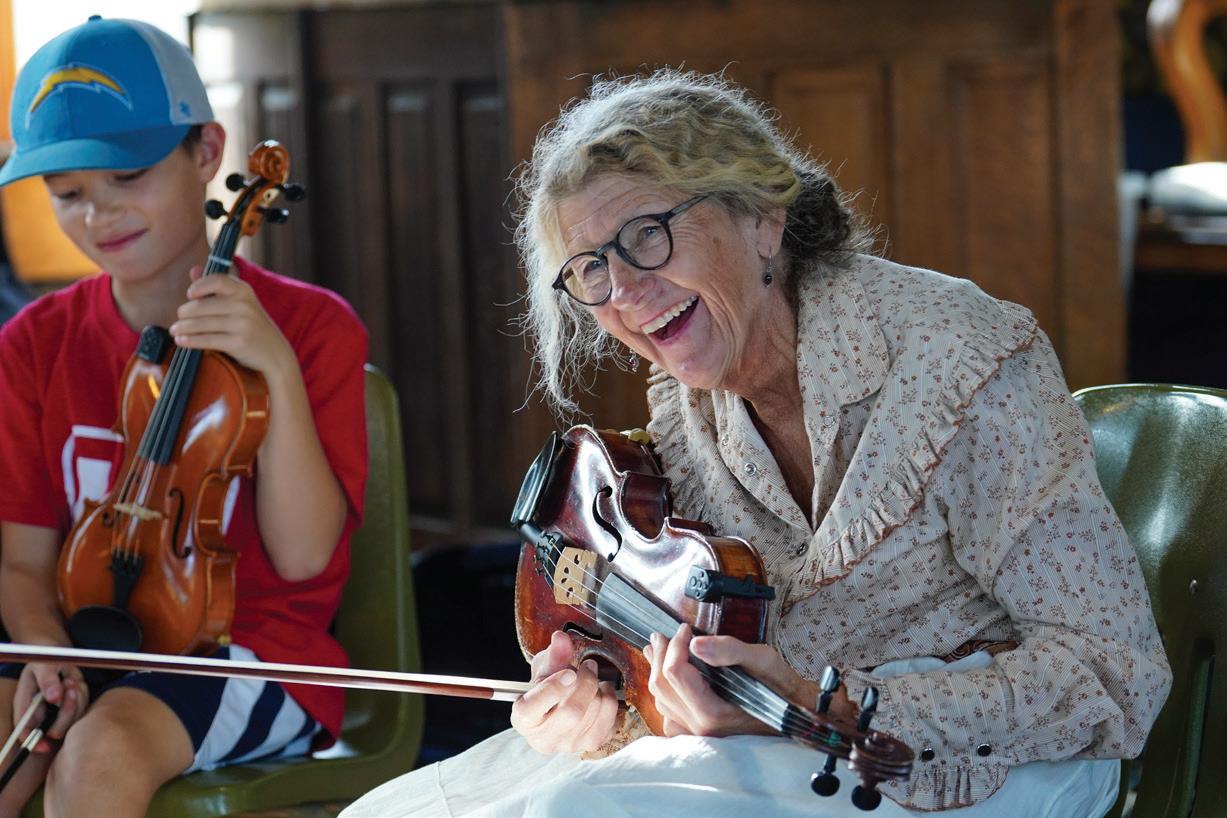


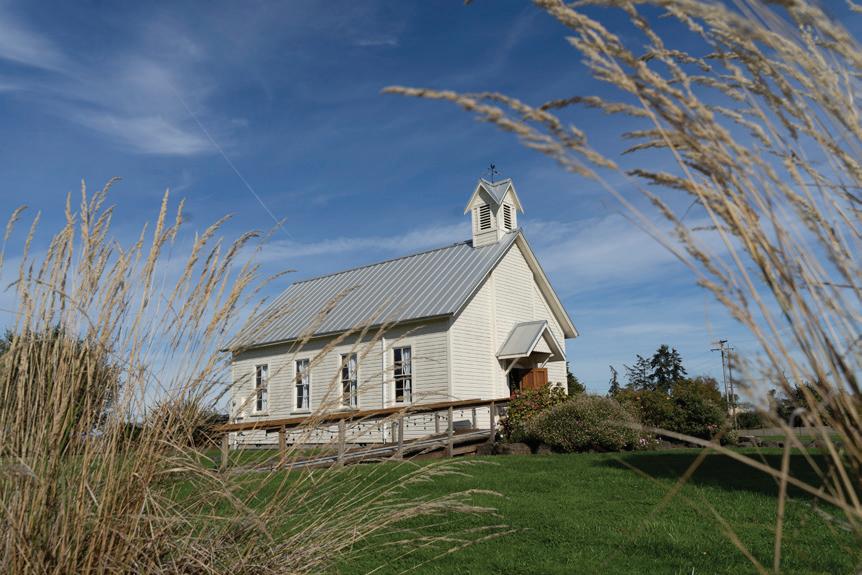
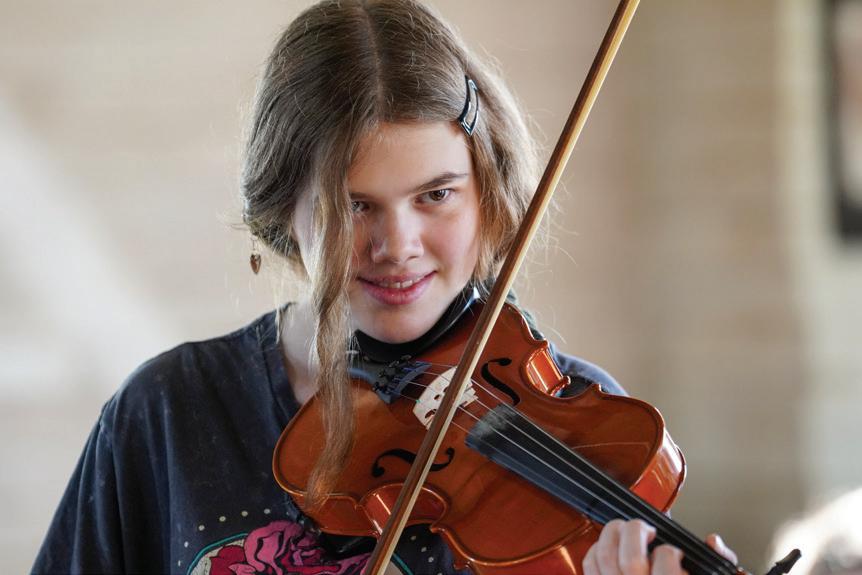
FROM
Sapphire Rain keeps a close eye on her instructor as she learns a new fiddle tune.
take a break from playing to dance. From left,
Leo
play along with the group. Anna Vane concentrates during class. Amy brings a lot of energy to the class as she teaches the students how to play in a jam session. The 1888 schoolhouse is a fitting setting for old-time fiddle music.
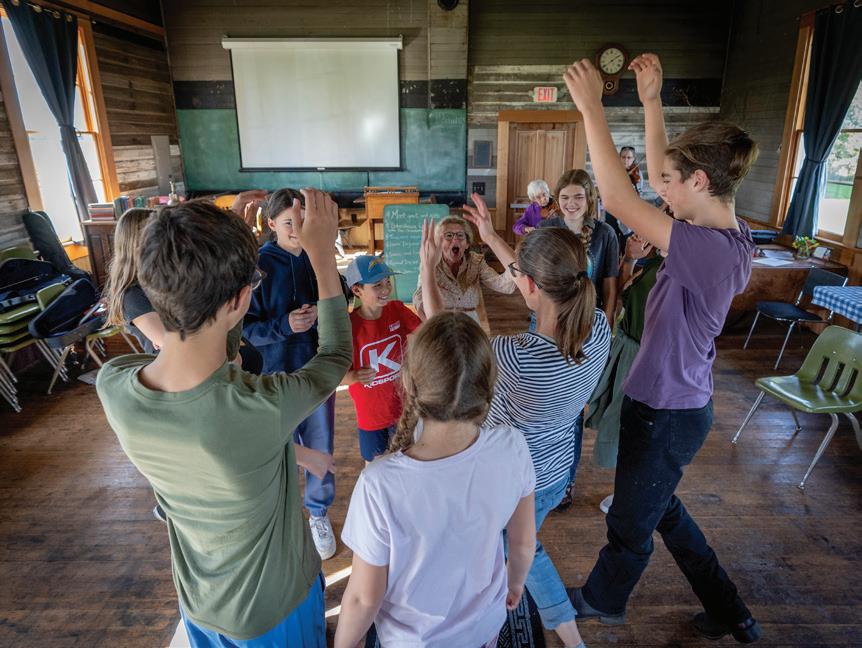
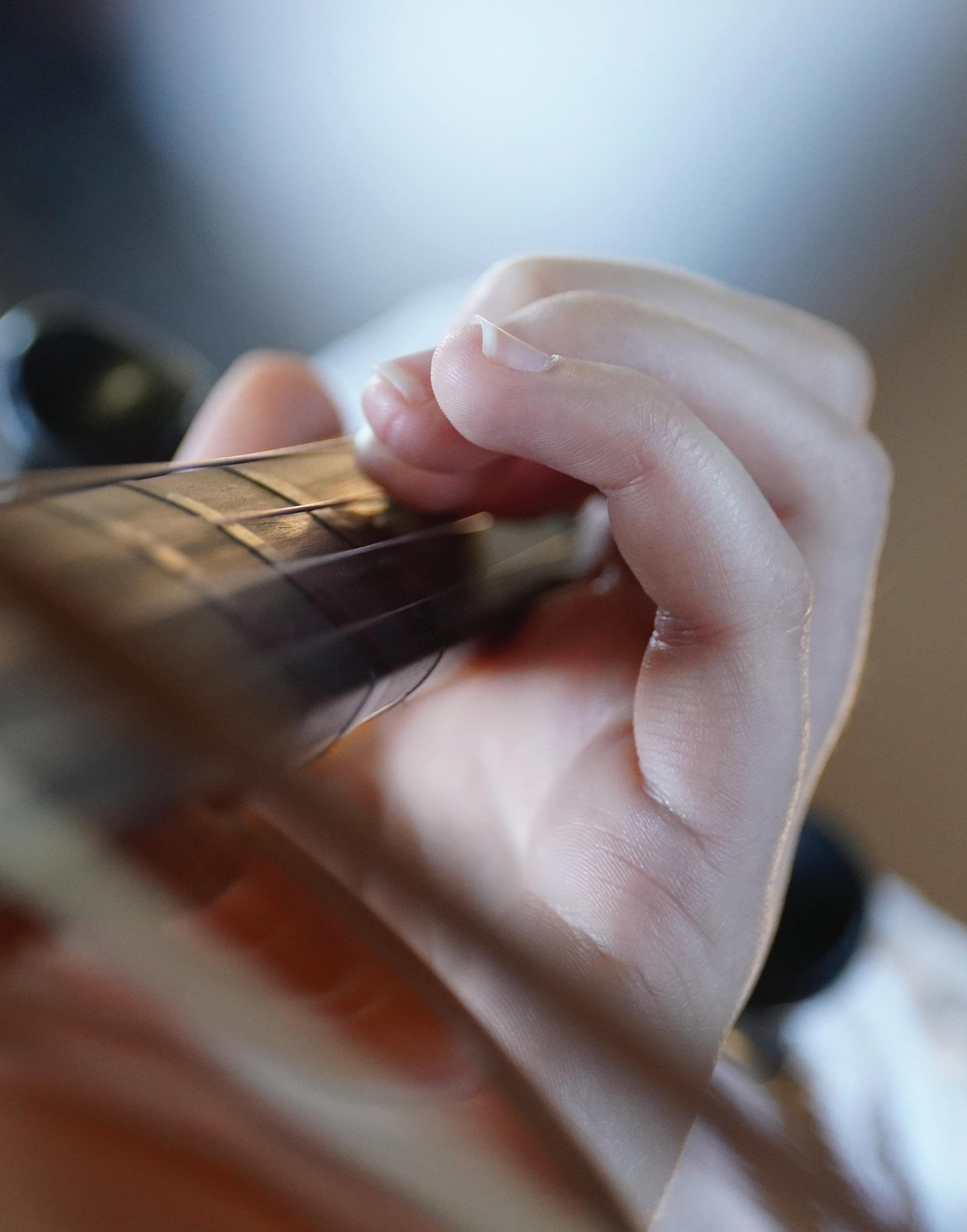


By Ginger Meurer
When Emily Black and her husband, Luke, started farming, they needed help.
“I went to the library and got every single farming book I could find, but that only takes you so far,” Emily says. “Then, there’s YouTube channels that you’re following, but they’re so generic. What about my area? What about my soil?”
To find those close-to-home answers, Emily turned to Annie’s Project at the University of Idaho Cooperative Extension.
Extensions services spread the mission of land-grant universities beyond campuses, reaching out to residents of all ages across America. Educational opportunities provided by extension services cover a wide range of topics, such as helping farmers grow crops and livestock, educating adults about gardening and health, and teaching youth hands-on skills.
University of Idaho Extension educator Colette DePhelps says Annie’s Project courses help women farm operators gain skills, manage risks and build professional networks. While participants have met in person in the past, recent sessions have been virtual—three hours weekly over 12 weeks.
Classes are structured to accommodate the realities of life.
“We know you are multitasking, and it’s fine,” Colette says. “It’s fine if your kids are on Zoom. It’s fine if you have to step away and come back. We totally understand. We’re a very welcoming class.”
Participants come from all scales of operations.
“Newer farmers are learning from farmers who have been farming for a long time,” Colette says. “But also, newer farmers have a different perspective, and they may be more comfortable with technology or direct marketing, so they have fresh ideas to share with more experienced farmers about reaching modern clientele.”
That was the case for Emily, who now teaches marketing strategy through the extension and offers one-on-one coaching through cultivatingyourmarket.com.
Annie’s Project is only one of a wide variety of courses offered through extensions. While 4-H youth development programs and

Master Gardeners community gardening experts are well known, extensions across the country lead a host of other projects they’re excited about.
In Twin Falls County, Idaho, extension educator Siew Guan Lee leads Kids in the Kitchen, a live online cooking program co-launched with the University of Georgia Cooperative Extension in 2020.
“One of the goals is that kids are the chef, and they’re making the meal for the family that night,” Siew says.
She started out offering kid-trusted basics with healthy twists, such as baked chicken nuggets and mac and cheese with broccoli. Participants encouraged Siew to embrace diverse dishes, including offerings from Mexico, Japan, Hawaii, Thailand, Ireland and more. Inspired by a colleague in Georgia, Siew also offers Southern dishes.
“And, of course, we’re Idahoans,” she says. “So, potatoes. We have to have that featured.”
Though the program is intended for Idaho residents, Siew says children log in from Wyoming, Washington, Utah, Oregon, Colorado, California and even Canada. And they aren’t just learning nutrition and food prep skills. They’re bonding with their sous-chef parent assistants.
“Parents said in their feedback that it actually improved their family dynamics,” she says.
Getting families involved in nutrition education was also one of the goals behind Washington State University-Chelan and Douglas Counties Extension’s Story Walk.
Extension director Margaret Viebrock says they teamed with Friends of the Library to select and dissect oversized nutritional picture books. They mounted pages on foamcore with English on one side and Spanish on the other, then took them on the road.
The first book was, “I Will Never Not Ever Eat a Tomato,” which was set up at the Master Gardeners’ Tomato Gala, an annual sample fest where the community votes on which tomato varieties the Master Gardeners grow for the spring plant sale.
The story walk was a hit with families strolling through, reading and collecting prizes after a quiz at the end. The project won a regional award and has been duplicated in half a dozen other extension offices in the state.
The extension also teaches nutrition basics in schools so children “understand that food doesn’t come from the back of a grocery store,” Margaret says. “There’s actually a farmer out there who grows it.”
The mission continues in community gardens, where aspiring green thumbs of all ages can rent small plots for the summer with water, seeds and a few starter plants included.
Lessons get serious when it comes to food preservation. It’s not like baking cookies, Margaret explains. If you’re out of chocolate chips and you substitute raisins, it’s still a cookie.
“With canning and preserving food, you just can’t make a substitution and put it in a sealed jar and expect it to be safe,” she says. “Just because it’s on the internet doesn’t mean it’s right. It’s important to know the source of a recipe to make sure it’s safe to use.”
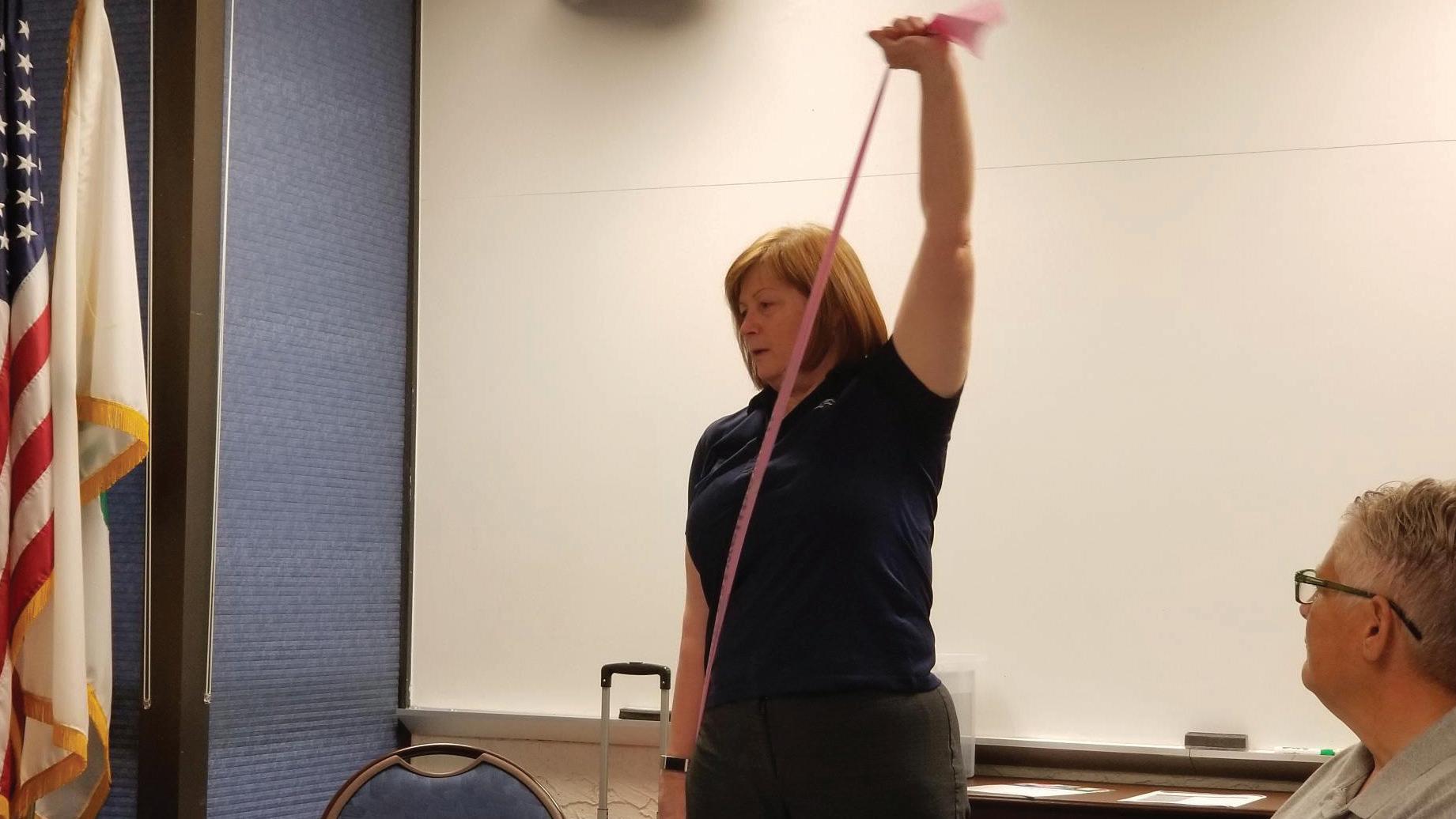
Saving lives is at the core of the Diabetes Prevention Program that University of Arizona Extension specialist Vanessa da Silva directs. The 12-month intensive course is targeted not at the 1 in 10 Americans who have diabetes but at the 1 in 3 who are prediabetic.
“We use the image of an iceberg,” Vanessa says. “What you can see above water are the people with diabetes. Underwater is this huge number of people that, if nothing changes, are very likely to progress to Type 2 diabetes. We’re trying to have an impact on that through extension.”
Participants in groups of 10 to 20 meet for 26 one-hour sessions over 12 months, starting weekly and easing toward monthly at the end. Lifestyle coach facilitators lead the sessions, but participants are encouraged to get involved.
“We really try to get people to work together and figure out for themselves,” Vanessa says. “What are the changes that they can make?”
Alfred McDonald of Tucson, Arizona, says he had “zero knowledge about diabetes” when he signed up for the program.
“I immediately started learning things out of the gate, like how to read a food label, carbohydrates, proteins, things like that,” he says.
Alfred lost 60 pounds, brought down his blood sugar and learned to manage his stress.
Southern Nye County Extension educator Hayley Maio says her extension operates in an area short on youth programs.
“We focus a lot on 4-H and positive youth development programs to help fill that gap,” she says. “It’s really fun to work with the kids and see them learning and blossoming.”
Tapping volunteers with expertise in a variety of backgrounds, the Southern Nevada extension gives youngsters a taste of robotics, creative writing, art, sewing, baking, gardening and more.
“Whatever kids are looking for or their parents think might be of interest to them, we try to make it happen,” Hayley says. "I’m a firm believer in if somebody wants it, we can figure out how to make it happen. If you can dream it, we can do it.”
Southern Nye County’s Master Gardeners and other adult programs have found success with online education, but when it comes to 4-H, in-person is vital “because it’s a learn-by-doing, experiential learning, hands-on type of program,” Hayley says.
In Washington, Whitman County Extension Office Acting Director Michael Gaffney says if he had to pick just one program he’s excited about, it would be 4-H robotics. He says the program is a science, technology, engineering and mathematics—or STEM—recruitment tool for student engagement in the sciences.
Regional and national competitions are great, but Michael says the real proof of the program’s success is watching kids head off to college to study things like engineering.
“For us, that checks all the boxes for 4-H,” he says.
Life on the Tundra
Hands-on education is so important to the Bering Strait Region Cooperative Extension that students are flown in three to four times a year for the High Latitude Range Management Program—an offering assistant professor Jackie Hrabok says is among the extension’s coolest.
The Western Alaska extension serves residents of Nome and 15 Alaska Native villages in the surrounding 36,000 square miles. Most of the area’s population is Inuit, living in villages off the road system across the Seward Peninsula.
Students learn to manage free-range reindeer that live alongside musk ox, caribou, arctic and red foxes and grizzly bears. They learn how many animals can survive on the rangeland, their preferred diets and how to prevent illness in the animals.
“Interactions between people and animals and the land is all part of the hands-on experience in the classroom and in the field doing field work and learning what type of techniques are used currently to monitor animals and the health of the land,” Jackie says.
The extension also taps the talents of community elders who take students out in the summer and prepare them to learn about plants by having them close their eyes.
“We will taste all the leaves of a variety of species of plants on the tundra,” Jackie says.
Food preservation lessons are also vital as communities deal with seasonal shortages. Jackie explains what changes in weather or delays in supply flights can mean.
“Your little village grocery store, quite often, might not be stocked with the nutrition that you seek,” she says. “So, you go on the land and in the waters, and you bring it home.”

Unlike other extensions tied to a single land-grant college, the University of California’s system taps talent and resources across all 10 University of California campuses while operating as its own entity. Brent Hales, associate vice president for research and cooperative extension, says extension advisers are on the ground throughout the state engaging with local governments, businesses, nonprofits and communities.
The extension operates nine research farms stretching from its borders with Oregon to Mexico. Newer agriculture projects step into the future with drones and robotics.
“We’re investing a lot of time, effort and resources into technology transfer and working with growers and companies to develop cutting-edge technologies,” Brent says. “We’re working with different community colleges and universities to engage both college and high school students in robotics competitions specifically designed to do workforce development to help kids see that they have a great future in agriculture, and they may not touch the dirt at all other than walking on it.”
The extension is also part of a disaster preparedness and resilience team launched in October to face “fire, flood, drought, you name it, climate, heat, human pandemic, animal pandemic, a whole litany,” Brent says.
Cooperative extensions provide practical resources and education, helping communities solve real-world challenges. Whether teaching kids to cook, supporting farmers or preserving local traditions, these programs build stronger, more resilient communities for the future. n
Visit extension.org/find-cooperative-extension-in-your-state to find the cooperative extension in your state.
Latin, Greek, rhetoric, history and mountains of memorization were all elements of the classical university education available to only an elite few Americans before the Civil War. Then, the nation’s education mission expanded on a path that resulted in the cooperative extension network.
X The Land-Grant College Act of 1862, called the Morrill Act for its sponsor, U.S. Rep. Justin Smith Morrill of Vermont, granted each state 30,000 acres of western land for each of its congressional seats to expand access to college education.
X In 1890, the second Morrill Act expanded the land-grant university funding system to the southern states. Native American tribal colleges were added with the Equity in Educational Land-Grant Status Act of 1994.
X In 1914, Congress passed the Smith-Lever Act, which established the Cooperative Extension Service. At the time the act was signed, more than 50% of the U.S. population lived in rural areas, and 30% of the workforce was engaged in farming, according to the United States Department of Agriculture.
X Today, roughly 17% of Americans live in rural areas. University extensions have offices in or near most of the country’s approximately 3,000 counties.

BY NATALIA
Collard Greens With Bacon
2 pounds collard greens
4 thick-sliced bacon strips, chopped
1 cup chopped onion
4 cups chicken stock
1/2 teaspoon garlic powder
1/4 teaspoon salt
1/4 teaspoon crushed red pepper flakes
Trim thick stems from collard greens, and coarsely chop leaves. In a Dutch oven, saute bacon for 3 minutes. Add onion. Cook until onion is tender and bacon is crisp, about 8 to 9 minutes. Add greens. Cook just until wilted. Stir in remaining ingredients. Bring to a boil. Reduce heat, and cover. Simmer until greens are tender, about 45 to 50 minutes.
3 Italian mild or hot sausage links, sliced
1 medium onion, finely chopped
4 garlic cloves, minced
11/2 teaspoons minced fresh thyme
1/2 teaspoon crushed red pepper flakes
2 tablespoons olive oil, plus extra for drizzling
64 ounces chicken broth
1 cup water
4 cups chopped fresh kale
15-ounce can cannellini beans, rinsed and drained
9 ounces refrigerated cheese tortellini
Freshly grated Parmesan, for garnish
In a large saucepan, cook the sausage, onion, garlic, thyme and pepper flakes in oil until sausage is no longer pink. Drain. Add broth and water, then bring to a boil.
Stir in kale and beans. Return to a boil, then reduce heat. Simmer, uncovered, until kale is tender. Add tortellini. Simmer, uncovered, for 7 to 9 minutes or until tender. Serve drizzled with olive oil and freshly grated Parmesan cheese.
2 extra-large egg yolks, at room temperature
2 teaspoons Dijon mustard, at room temperature
2 teaspoons chopped garlic
10 anchovy fillets
1/2 cup freshly squeezed lemon juice, at room temperature
1/2 teaspoon freshly ground black pepper
2 teaspoons kosher salt
11/2 cups good-quality mild olive oil
1/2 cup freshly grated Parmesan cheese, plus extra for garnish
1 tablespoon salt
8 cups broccoli florets, stems removed
1 bunch baby kale
5-ounce bag croutons
Place the egg yolks, mustard, garlic, anchovies, lemon juice, ½ teaspoon pepper and 2 teaspoons salt in the bowl of a food processor fitted with the steel blade. Process until smooth. With the food processor running, slowly pour the olive oil through the feed tube, and process until thick. Add the cheese, and pulse three times to combine. Bring a large pot of water with 1 tablespoon of salt to a boil. Fill a bowl with ice water. Add the broccoli to the boiling water, and cook for 4 minutes. Remove the broccoli with a slotted spoon, and transfer to the bowl of ice water. When it is cool, drain well and transfer to a large bowl. Remove and discard any hard ribs from the kale. Stack the leaves on top of each other, and thinly julienne them crosswise. Add to the bowl with the broccoli. Add enough dressing to moisten the broccoli and kale. Toss well. Add the croutons, and garnish with extra Parmesan.
6 boneless skinless chicken thighs (about 11/2 pounds)
1/2 teaspoon seasoned salt
1/2 teaspoon pepper
11/2 teaspoons olive oil
4 shallots, thinly sliced
1/3 cup white wine or chicken broth
10 ounces fresh spinach
1/4 teaspoon salt
1/4 cup sour cream
Sprinkle chicken with seasoned salt and pepper. In a large nonstick skillet, heat oil over medium heat. Add chicken. Cook until a thermometer reads 170 F, about 6 minutes on each side. Remove from pan, and keep warm.
In the same pan, cook and stir shallots until tender. Add wine, and bring to a boil. Cook until wine is reduced by half. Add spinach and salt. Cook and stir just until spinach is wilted. Stir in sour cream. Serve mixture with chicken.
4 slices pancetta, chopped
2 tablespoons olive oil
1/4 cup chopped onion
2/3 cup cherry tomatoes, halved
1 teaspoon minced fresh rosemary
1/4 teaspoon salt
1/4 teaspoon pepper
2 15-ounce cans cannellini beans, rinsed and drained
3 tablespoons red wine vinegar
4 fresh basil leaves, thinly sliced
2 cups torn fresh arugula
1/4 cup shaved Parmesan cheese
In a small skillet, cook pancetta over medium heat until crisp, stirring occasionally. Remove with a slotted spoon, and drain on paper towels.
In the same pan, heat oil and pancetta drippings over medium heat. Add onion. Cook and stir 1 to 2 minutes or until tender. Add tomatoes, rosemary, salt and pepper. Cook 2 to 3 minutes longer or until tomatoes are softened. Cool slightly.
In a large bowl, combine beans, tomato mixture, pancetta, vinegar and basil. Add arugula and cheese. Toss to coat.
Free to an appreciative home. Almostcomplete sets of “Idaho Magazine” years 2018-24. Pick up at my address in Idaho or by arrangement in Netarts, Oregon. Will ship by UPS if prepaid.
Jim Fazio 1049 Colt Road Moscow, ID 83843
Looking for used postcards featuring the greater Bend/Central Oregon area with writing on the back. These likely would have been from people visiting the area and mailing postcards to friends or family in other parts of Oregon or other states. Thank you.
J. Stephens 19110 Buck Drive Bend, OR 97703
Please help with a legacy artwork of black and white photography portraits for my art project. I will email you a photo of the final. I don’t have any photos of family, so anything will be appreciated. I’m a hobbyist, not a professional photographer.
NJ Bittick 1009 Orchard St. Susanville, CA 96130
I have many used greeting and Christmas cards and a surplus of wrapping paper. If anyone would like to have some of these for a project, I will help with shipping.
Tam Judy 456714 Highway 95 Careywood, ID 83809 jslashbrand@gmail.com
Our father, Marvin, will celebrate his 89th birthday in February. When he was in his 20s, he was stationed with the Air Force in Alaska and never left. He has been in Alaska for over 65 years, worked for the FAA, owned a construction company and enjoyed years of wilderness adventures. Please send to, Marvin Hassebroek, 518 Slater Drive, Fairbanks, AK 99701
Melanie Hinzman Fairbanks, Alaska
Our wonderful grandmother Marian celebrates 100 years in February. Longtime residents of Brookings-Harbor will remember her beautiful smile and gracious presence working at her in-laws mercantile, Hanscam's Store, following her move to Oregon from Kentucky with her Fort Knox soldier after the war. She still attends mass and bakes a terrific cookie. If you care to send a card, poem, cookie or bar recipe, recollection, postcard, etc., to her c/o of me, I'll be sure to deliver them on her birthday. Thank you in advance for sending cheer.
Marian, c/o Cora Rose P.O. Box 490 Brookings, OR 97415
My father-in-law, Elisardo “Alex” Camarillo, will turn 100 in February. Alex was raised in Southern California and served in World War II as a Private First Class from 1942-1945. After the war, he returned to Southern California working on some of the large ranches, such as the Rancho Santa Margarita. He learned to train horses and also worked as a farrier. He moved to Oregon in 1948 and raised his family near Carlton. He continued to work as a farrier until he was 80 years old. It would be wonderful if he could receive cards from you for this special event. Please send cards to Elisardo “Alex” Camarillo, 400 Frank Gilliam Drive, Apt. #15, Heppner, OR 97836.
Sharon Camarillo
Heppner, Oregon
I'm looking for new dinner recipes to add to my family's collection. I would love meals that can be prepared in advance and frozen for later use. If you have a favorite family recipe, please share it with me by email or mail. Thank you.
Stefanie Steward P.O. Box 566 Susanville, CA 96130 stefsteward@gmail.com
Send your request—with no attachments—to readerexchange@ruralite.org or mail to Reader Exchange, 5625 NE Elam Young Parkway, Suite 100, Hillsboro, OR 97124. Fill in the subject line with Reader Exchange. Acceptance, scheduling and editing are at the editor’s discretion. Single requests only, please. No duplicates. Submissions are handled on a first-come, first-served basis and as space allows. We cannot honor every request.
Please affirm you have authorization from all appropriate parties before submitting. By submitting, you indemnify Reader Exchange, Pioneer Utility Resources Inc., its officers, directors, employees, utility clients and insurers from all legal liability incurred by the publication of information.
We no longer accept pen pal requests. You may submit a pen pal request as a Marketplace ad. Marketplace pricing applies.
When submitting a milestone request, please send it at least two months before the milestone.
Phone numbers will not be published. Email addresses will be published if part of the ad, but the request must include a postal address.
Request must include the name and address of the electric utility that provides your magazine.
See bluffs, beaches and history in

Walk into history at Ebey’s Landing National Historic Reserve in the far reaches of Northwest Washington. The reserve, on Whidbey Island near the Canadian border, features unique plants and habitats, tall bluffs that lower into the sea and centuries of historic structures.
First National Historic Reserve
Whidbey Island has been home to many over thousands of years, and, for a long time, was part of the territory of the Lower Skagit tribe. In the mid-1800s, settlers came to the area for the great soil and maritime benefits. In 1978, the area became the United States’ first National Historic Reserve to preserve the natural landmarks and farms that tell the story of rural life.
Ebey’s Landing has more than 30 miles of hiking and biking trails through forests and prairies and along coastline. The Bluff Loop trail and Ebey’s Prairie Ridge trail are popular. Ebey’s Landing is also home to a beach with miles of shoreline, and nearby Crockett Lake is a popular spot for birders during migration seasons.
Inside the reserve are three state parks. Fort Casey State Park is home to a fort built in the late 1800s that was used during World War II and Admiralty Head Lighthouse. Fort Ebey State Park is home to another fort used during WWII and many popular trails.
Ebey’s Landing State Park includes the Bluff Loop Trail and many other sweeping viewpoints.
Weather on the reserve is known to change quickly, and quick rainstorms can cause trails to become slick or even cause landslides. The reserve is not all public land—85% of the reserve’s area is privately owned. Please avoid private property. Entering the reserve is free, but entering any of the state parks requires a discovery pass—$10 for a day or $30 for an annual pass. To start planning your trip, visit nps.gov/ebla or call 360-678-6084.
People don’t always do what their doctor says, but when seasoned veteran emergency room physician, Dr. Philip B. Howren, says every senior should have a medical alert device, you better listen up.
“Seniors are just one fall away from being put in a nursing home,” Dr. Howren said. “With a medical alert device, seniors are never alone. So it keeps them living independently in their own home. That’s why seniors and their family members are snapping up a sleek new medical alert device that comes with no monthly bills ever,” he said.
Many seniors refuse to wear old style help buttons because they make them look old. But even worse, those medical alert systems come with
monthly bills.
To solve these problems Universal Physicians, a U.S. company went to work to develop a new, modern, state-of-the-art medical alert device. It’s called “FastHelp™” and it instantly connects you to free unlimited nationwide help everywhere cell service is available with no contracts, no deposits and no monthly bills ever.
“This slick new little device is designed to look like the pagers doctors wear every day. Seniors love them because it actually makes them look important, not old,” Dr. Howren said.
FastHelp is expected to hit store shelves later this year. But special newspaper promotional giveaways are slated for seniors in select areas. ■

■ NO MONTHLY BILLS: “My wife had an old style help button that came with hefty bills every month and she was embarrassed to wear it because it made her look old,” said Frank McDonald, Canton, Ohio. “Now, we both have FastHelp™, the sleek new medical alert device that our grandkids say makes us look ‘cool’ not old,” he said. With FastHelp, seniors never have to worry about being alone and the best part is there are no monthly bills ever.
It’s just what seniors have been waiting for; a sleek new medical alert device with no contracts, no deposits and no monthly bills that instantly connects you to free unlimited nationwide help with just the push of a button for a one-time $149 price tag that’s a real steal after today’s instant rebate
The phone lines are ringing off the hook.
That’s because for seniors born before 1961, it’s a deal too good to pass up.
Starting at precisely 8:30am this morning the Pre-Store Release begins for the sleek new medical alert device that comes with the exclusive FastHelp™ One-Touch E 911 Button that instantly connects you to unlimited nationwide help everywhere cell service is available with no contracts, no deposits and no monthly bills ever.
“It’s not like old style monitored help buttons that make you talk to a call center and only work when you’re at home and come with hefty bills every month. FastHelp comes with state-of-theart cellular embedded technology. That means it works at home or anywhere, anytime cell ser
(Continued on next page)

(Continued from previous page)
vice is available whether you’re out watering the garden, driving in a car, at church or even hundreds of miles away on a tour or at a casino. You are never alone. With just a single push of the One-Touch E Button you instantly get connected to free unlimited help nationwide with no monthly bills ever,” said Jack Lawrence, Executive Director of Product Development for U.S. based Universal Physicians.
“We’ve never seen anything like it. Consumers absolutely love the sleek new modern design and most of all, the instant rebate that practically pays for it and no monthly bills ever,” Lawrence said.
FastHelp is the sleek new medical alert device with the best of combinations: a quality, high-tech engineered device that’s also an extremely great value because there are no monthly bills ever.
Better still, it comes with no contracts, no deposits and no monthly bills ever – which makes FastHelp a great choice for seniors, students and professionals because it connects to one of the largest nationwide networks everywhere cell service is available for free.
And here’s the best part. All those who already have an old style monitored medical alert button can immediately eliminate those monthly bills, which is why Universal Physicians is widely advertising this announcement nationwide.
“So if you’ve ever felt a medical alert device was too complicated or expensive, you’ll want to get FastHelp, the sleek new medical alert device with no monthly bills,” said Lawrence.
The medical alert device slugfest was dominated by two main combatants who both offer old style monitored help buttons that come with a hefty bill every month. But now Universal Physicians, the U.S. based heavyweight, just delivered a knockout blow sending the top rated contenders to the mat with the unveiling of FastHelp. It’s the sleek new cellular
embedded medical alert device that cuts out the middleman by instantly connecting you directly to highly trained 911 operators all across the U.S. There’s absolutely nothing to hook-up or install. You don’t need a land line and you don’t need a cell phone. Everything is done for you.
“FastHelp is a state of the art medical alert device designed to make you look important, not
old. Old style monitored help buttons you wear around your neck, or require expensive base station equipment or a landline are the equivalent of a horse and buggy,” Lawrence says. “It’s just outdated.”
Millions of seniors fall every year and spend hours lying on the floor helpless and all alone with no help.
But seniors who fall and get immediate help

are much more likely to avoid getting sent to a nursing home and get to STAY living in their own home independently.
Yet millions of seniors are still risking their safety by not having a medical alert device. That’s because seniors just can’t afford to pay the monthly bills that come with old style medical alert devices.
That’s why seniors born before 1961 are rush-
ing to cash in the whopping $150 instant rebate before the 21 day deadline ends.
So there’s no need to wait for FastHelp to hit store shelves later this year because seniors born before 1961 can get it now just by using the $150 instant rebate coupon printed in today’s newspaper before the 21 day deadline ends. If lines are busy keep trying, all calls will be answered. ■
Use the rebate coupon below and call this Toll-Free Hotline: 1-800-330-4294 DEPT. HELP8438
BORN AFTER 1961: You cannot use the rebate coupon below and must pay $299 Call: 1-800-330-9423 DEPT. HELP8438
THE BOTTOM LINE: You don’t need to shop around. We’ve done all the leg work, this deal is too good to pass up. FastHelp with the instant rebate is a real steal at just $149 and shipping and there are no monthly bills ever.
PROS: It’s the sleek new medical alert device that comes with the exclusive FastHelp One-Touch E 911 Button that instantly connects you to free unlimited nationwide help everywhere cell service is available with no contracts or deposits. It connects you to the vast available network of cellular towers for free and saves seniors a ton of money because there are no monthly bills ever making this deal irresistible. Plus it’s the only medical alert device that makes seniors look important, not old.
CONS: Consumers can’t get FastHelp in stores until later this year. That’s why it’s so important for seniors born before 1961 to call the National Rebate Center Hotline within the next 21 days. For those who miss that deadline, the sleek little medical alert device will set you back over $300 bucks.










By Dave LaBelle
Without darkness, I would never know light. I have heard variations of this truth since my youth.
Though we often speak about contrast—the degree of difference between the darkest and lightest parts of an image—there is another form of contrast that emphasizes the variances between subjects in a composition. And while, generally, we want a photograph to have good tonal range, compositionally, contrasting subjects can also be important for storytelling impact.
For instance, positioning someone tall next to someone short in the same frame helps show the height differential. The same goes for the contrast of a man dressed in an expensive, tailored suit passing by a man partially clothed in soiled rags, communicating the different place in life each occupies.
Henry Cartier-Bresson’s photographs of children playing in war-torn ruins or children pushing a steel hoop down the street as a hearse passes behind them and Margaret BourkeWhite’s 1937 Great Depression image of hungry people in a breadline as a billboard behind
them shows a smiling family in a nice car are examples of iconic photographs employing the concept of contrast.
Of the tools in a writer’s and photographer’s toolbox, the use of contrast can be a powerful and effective device to quickly communicate ideas and concepts. n
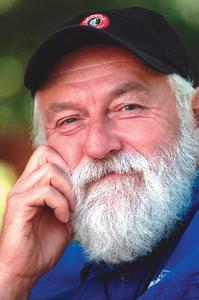
Renowned author, photographer and lecturer Dave LaBelle has captured special moments for more than half a century. For more of his writings, visit davidlabelle.com and bridgesandangels.wordpress.com.
See if you can capture or make a photograph that tells a story by using a contrast of subjects. Consider a still-life composition of objects, such as your child’s baby shoes arranged next to their grown-up shoes. It’s a way of revealing time passed. Or illustrate aging with a photograph of a frisky new puppy crawling over a tired, old dog.
Email your best image (just one, please) with caption information, including an explanation of how it affects you, to gph@pioneer.coop. We may share submissions on our website and social media channels.












































May 18, 1980, the once-slumbering Mount St. Helens erupted in the Paci c Northwest. It was the most impressive display of nature’s power in North America’s recorded history. But even more impressive is what emerged from the chaos... a spectacular new creation born of ancient minerals named Helenite. Its lush, vivid color and amazing story instantly captured the attention of jewelry connoisseurs worldwide. You can now have four carats of the world’s newest stone for an absolutely unbelievable price.
Known as America’s emerald, Helenite makes it possible to give her a stone that’s brighter and has more re than any emerald without paying the exorbitant price. In fact, this many carats of an emerald that looks this perfect and glows this green would cost you upwards of $80,000. Your more beautiful and much more a ordable option features a perfect teardrop of Helenite set in gold-covered sterling silver suspended from a chain accented with even more verdant Helenite.

Helenite Earrings -a $129 valuewith purchase of Helenite Necklace

Limited Reserves. As one of the largest gemstone dealers in the world, we buy more carats of Helenite than anyone, which lets us give you a great price. However, this much gorgeous green for this price won’t last long. Don’t miss out. Helenite is only found in one section of Washington State, so call today! Romance guaranteed or your money back. Experience the scintillating beauty of the Helenite Teardrop Necklace for 30 days and if she isn’t completely in love with it send it back for a full refund of the item price. You can even keep the stud earrings as our thank you for giving us a try.
Helenite Stud Earrings (1 ctw)
Helenite Set (5 ¼ ctw) $428*
earrings)




Story and photo by Michael Rovito
We landed in Utqiagvik, formerly known as Barrow, before the sun came up. The farthest north Arctic community in the United States sat cocooned under a blanket of snow in the brisk air of winter. It was Dec. 17, and the sun would eventually rise, but we would have to be very patient. The next time its rays would peek above the horizon would be Jan. 22.
This was polar night. For Utqiagvik, and places at a similar latitude, it meant 24 hours of darkness for more than two months.
Exiting the jet, a bitter breeze brushed our faces as we ducked through the door to descend on to the frosty tarmac. From the vantage at the top of the jetway stairs, the shining lights of the town spread out beyond like scattered embers strewn across a blank canvas. Where the lights stopped, the vast Arctic Ocean, itself hidden under thick ice, began.
To an outsider, traveling to Utqiagvik in the winter can be an otherworldly experience. Like the planet Hoth in Star Wars, everything is frozen. But unlike the poor experience the Rebel Alliance had on Hoth, Utqiagvik is full of warm people who smile through the dark winter and make visitors feel welcome.
There must be something about living in an isolated community with such drastic climatic conditions that brings about the best in people. That probably makes sense, since a town full of curmudgeons with no easy way out would be hard to endure.
Alaska is no stranger to winter, but user experiences may vary. Many parts of the Southeast Panhandle see more rain than snow during the winter months, while parts of Southcentral Alaska can seesaw between bitter cold and relatively mild temperatures. Snow and wind are a certainty, along with winter storms that pack such
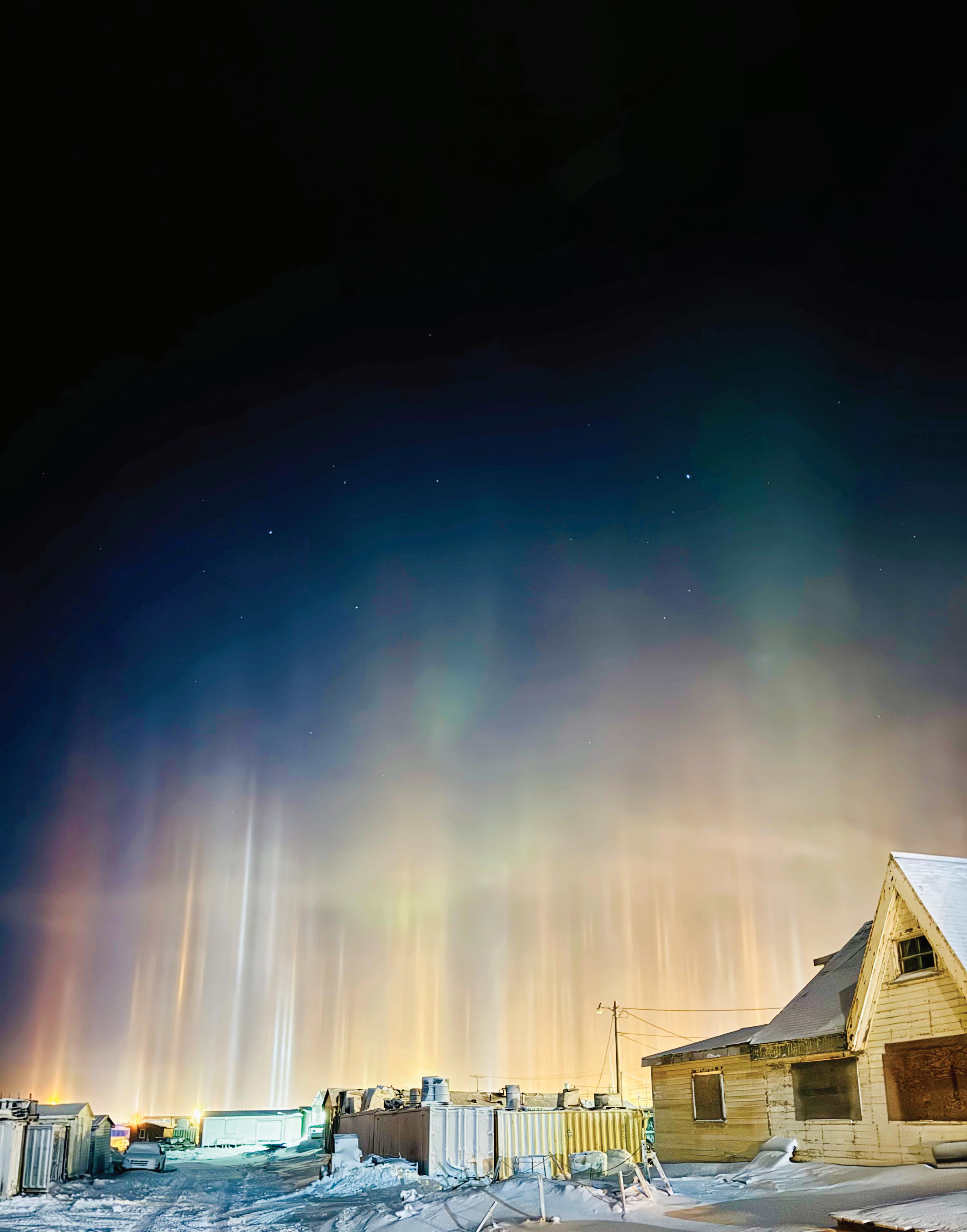
a punch their occurrence would be national news for a week if they hit anywhere else in the country besides Alaska.
But the Arctic is a different place all together.
On Nov. 18, 2024, the sun set in Utqiagvik, marking the beginning of a 65-day polar night. During this period, the sun doesn’t rise. Although a faint glow may appear above the southern horizon at midday, it is fleeting. For most of the polar night, the sky remains an inky black, illuminated by countless stars that shine brilliantly in the darkness.
The long dark doesn’t slow the community. In Utqiagvik, life goes on. The sun may not rise, but the people still do. They go to work. They make art. They learn and teach. They welcome visitors and old friends, and carry on much of the traditional way of life that has existed in the far north for thousands of years.
The experience of polar night is fascinating and maybe even a bit discombobulating. No matter when you wake up, it’s dark out. Without a watch or clock nearby, it’s hard to know the time. It could be morning, night or midday.
That darkness brings with it beauty, if you know where to look. Standing near Utqiagvik’s famous whale bone arch, the air above our heads was full of tiny ice crystals. Suspended in the deep cold of the Arctic air, the crystals became mirrors, creating light pillars above the town. Reaching straight into the sky, the lights shone upward in brilliant greens, yellows, blues and purples. And for good measure, nature threw in some dim northern lights. Suddenly, the 22 below zero wind chill wasn’t so apparent. The spectacle in the sky above frozen Utqiagvik made it seem like the world had stopped. For just a minute or two, the polar night was alight with color. The brutal cold and dark had birthed something the summer months could not bring: A splendor in the sky. n
Agriculture
4x5 round bales, Meadow Foxtail Orchard Grass. 4x4 Timothy, small square. 208-4354637 or 208-435-4002; nas@cpcinternet.com. 1225
Reinforced custom-sized pond liners (39 cents/sqft). Hay covers, greenhouse covers, any width and length. Truck tarps and more. High puncture and tear strength. Best price guaranteed. Celebrating 43 years in business. www.btlliners.com. 541-447-0712. 0425
Antiques and Collectibles
Buying antiques and collectibles: advertising signs, porcelain signs, gas pumps, beer signs, antique toys, cast-iron coin banks, neon signs and more. Jason, 503-310-3321 or tjabaughman@yahoo.com. 0325
Buying American Indian collectibles, Navajo blankets and rugs, baskets, beadwork, etc. Also, quality paintings of the early Southwest and Americas. Call 760-409-3117 or send photos to amer.ind.baskets@gmail.com. 0225
Books, Magazines and Videos
Book restoration. Bibles, cookbooks, cherished family heirlooms. Beautiful work. We give renewed life, more durable than original, to last for generations. 775-537-7066; salacanstudio@gmail.com. 0225AR Business Opportunities
For sale: successful Northeast Oregon drive-in diner. Union, OR. Owner wishes to retire after 28 years. RMLS #24493530. Walt BrookshireBroker, Oregon Trail Realty, 541-805-8689. $185K. 0325
Tremendous opportunity to own restaurant, bar, liquor store with pull tabs and lotto sales near Fairbanks, AK. Located near university, airport and musk ox farm. Ivory Jacks since 1975. $1.4M; 5.9 acres. Dick: home, 907-455-6666; cell, 907-888-6668; dickells74@gmail.com. ivoryjacksrestaurant.com. 0225
Community Events
Celestial Resonance by Darcy Dolge. Feb. 7March 29, 2025. Art Center East, La Grande, OR. A multisensory exhibit combining art and sound. artcentereast.org. 0225
Equipment and Tools
Fireproof combination lock safe, $300. DR multi trimmer, $300. Kubota tow rototiller, $1.75K. Land pride 4-ft. mower, $800. Ted, 458-910-3727. 0225
Ads 25 words or fewer are $35 a month. An extended ad of up to 35 words is $50 a month. Contact information is included in the word count. Phone numbers and emails count as one word.
Longer ads may be placed. Contact 503-357-2105 or info@pioneer.coop for pricing information.
Ads are for customers of member co-ops, public utility districts and municipals only. Subscribers and nonmembers may inquire about pricing at 503-357-2105 or info@pioneer.coop.
Ads must be direct and in first person, and are subject to approval and editing.
Closing deadlines (in our office): April issue—Feb. 28, 2025.
If submitting ad by mail, send appropriate payment with your name, address, email, phone number and the name of the electric utility that provides your magazine to: Marketplace, P.O. Box 1306, North Plains, OR 97133. Make check or money order payable to Ruralite.
We accept credit card payments for ads submitted by email. Send ad to info@pioneer.coop. Call 503-357-2105 to pay by credit card.
For Rent, Lease
NE, OR. 1 bd, 1 ba, bonus room. Nice smaller home. Water/sewer/garbage paid. $650 month/plus deposit. 55-plus preferred. Phone calls only. 541-519-3400. 0225
Free Items
Free materials—church, government uniting, suppressing “religious liberty,” enforcing National Sunday Law. Be informed. Need mailing address only. TBS, P.O. Box 374, Ellijay, GA 30540. tbsmads@yahoo.com; 888-211-1715. 0325AR
Livestock, Supplies
28th annual Oft Angus Bull Sale. March 20. Producers sale yard, Vale. Selling 90 fall and 2-year-old bulls. Terry, 208-741-0824, or Colleen, 208-202-8352. 0325
Miscellaneous
Foster parents needed to care for teen youth in Wasco and Hood River counties. Agency provides on-call support, training, $2.1K/youth monthly reimbursement, 2 days off/month. Fosterinfo@nextdoorinc.org; 541-308-2207. 0625
Advertisements are accepted in good faith. Pioneer Utility Resources is not liable for interactions between buyers and sellers. Your ad could be here in April. See instructions above for details.
Looking for that special knife? I hand make custom hunting and fishing knives. I also make other metal and woodcrafts. 559-212-0693; Buckeyeknives.com. 0225
Local commercial fisherman sells summer catch of preserved freshness by blast freezing at sea, gourmet canned tuna on internet. Sept.June. 100% guaranteed the best canned tuna you ever tasted. Original, jalapeno and garlic flavors available. To order: twofisherstuna.com or 206-799-1082. 0225
Granite cemetery markers at affordable prices. Will ship to most places. For more info: Joe, highdesertmemorials@gmail.com or 541-815-8906; www.highdesertmemorials.com. Pets and Supplies
Border collie/McNab puppies. The best dog you will ever have. Males and females, $450 each. Colton, OR. 503-314-0145. 0225
$180K. 160 acres, proven gold claims. 131 miles north of Fairbanks, AK. 50-yard-per-hour shaker plan. Complete water system. Text, 907-223-3036. 0225
Let me help you buy or sell ranch, farm and recreation property in OR. Fourthgeneration Oregonian, prior ranch owner. For sale: Klamath Marsh, OR. 173.65 acres. $2.5M. Guest Ranch Overlay. John Gill, 541-480-9161; johngill@landandwildlife.com. Land And Wildlife brokerage. 0225
Dale store. Live/work in a recreational enthusiast’s location, store, fuel, post office, home, game cooler. $325K. Duke Warner Realty, 541-987-2363, ddwr@ortelco.net. 0225
3 beautiful 1.01-acre lots in Pahrump, NV. Awesome mountain view in nice area. No HOA. $30K each or two for $55K. Easy access to off-roading. Horses OK. Also 10-acre lot with water rights and underground utilities. pkcfitness@hotmail.com. 775-209-2830. 0225
320 acres east of Adel, OR. Borders Hart Mountain views, Steens Mountain and Beaty Butte. Landowner tags, very rural. $263K. For maps, contact: 541-659-1573; thejugglingman3@gmail.com. 0225
Recreational Rentals
Bed and Birds; a guesthouse. Wet meadows, range, forest, dark sky. Beds for 9. Lakeview, OR. Explore or ride? Near ski hill. Reasonable. 541-219-2044. 0425
Bend country cabin. Very clean and fully furnished cabin on private ranch. Close to recreation areas. Very nice. $95/night. 541-382-3050; bendcountrycabins@gmail.com. 0325
Wavecatcher: oceanfront cottage. Central Oregon Coast. $175/night (plus cleaning/tax). Open April through Oct. Holds up to 6-plus kids and pets. Wavecatcherbeachrentals.com. Reservations: 541-740-2846. 0325
Dry cabin and bunkhouse rental near Freeman Creek on Dworshak. Fully furnished. Outhouse and outdoor shower. Sleeps 6. No animals. April through Oct. Reservations: DebbieL1213@gmail.com. 0225
Cabin rental in Eagle Lake, CA. 3 bd, $175; summer rate. Memorial weekend-Oct. Winter months: Nov.-Feb.; $225. 3 miles to marina. Reservations, 530-310-5320. 0225 Recreational Vehicles
Thor A.C.E model 27.2, 2017 motor home. Excellent condition. 14K miles, 2 slides. Sleeps 6, 2 TVs, always covered. $60K. debutler1947@icloud.com; 541-953-0295. 0225
24-ft. Sunseeker RV Mercedes. Diesel, 8-ft. slide out with 4-person dinette, sleeps 6. 60K miles, 2016. $48.5K. Ted, 458-910-3727. 0225
2008 Lance truck camper with slide, model number 1181. Fully loaded; excellent condition. Onan generator, solar panel, wooden interior. $15K. Pahrump, NV. 775-990-0028. 0225
Dawn Till Dusk Masonry. Brick, block, stone and pavers. Small jobs and repairs welcome. dawntillduskconstructionmasonry.com. 541-388-7605; 541-410-6945. License #245760 bonded and insured. La Pine, OR. 0225
Writing and grammar coach with 35 years experience teaches students 12 and older. Local hybrid in Manzanita, OR, or all online. $100/class. writingtutor22@gmail.com; Louisapeck.com. 0225
All types of roofing and repairs, family business since 1956 where integrity prevails. Dave, 541-852-2816. Josh, 541-255-6031. 0425
Grandsons want Damon Howatt bow’s and arrows for target and or hunting. Bill Howat, text pictures of equipment: 509-837-8695. Swaps and Trades
Private horse ranch in Sisters, OR, offers an RV spot for your RV living in trade for light horse feeding and cleaning. TK, 541-504-1234. 0225
Old carpenter tools, planes (wood/metal), levels, chisels, slicks, adzes, axes, hatchets, handsaws, old rulers, spoke shaves, wrenches, shipwright tools, old tool chests. 503-659-0009; 971-666-0659. 0225
Gold, silver, coins/currency, buy, sell. Collections wanted. Fair prices paid. 44 years in retail store. Baker City, OR. 800-556-2133; garrymclin@aol.com. 1025
Buying American Indian collectibles, Navajo blankets and rugs, baskets, beadwork, etc. Also, quality paintings of the early Southwest and Americas. Call 760-409-3117 or send photos to amer.ind.baskets@gmail.com. 0225
Cash paid for old gas station and oil company signs, pumps, globes, metal oil cans. Good condition. Discreet cash settlement. Clifton Jones, collector. 512-413-4459. 0225

Nothing brings family together like food, but what are our readers’ favorite dishes? Check out nearly 300 recipes for appetizers, drinks, main dishes and desserts from our 2013 contest. The book is $10 (includes postage).
TO ORDER BY MAIL: Submit payment with cookbook title, your name, address and number of cookbooks wanted to: Ruralite Cookbooks P.O. Box 1306 North Plains, OR 97133
TO PAY BY PHONE: Call 503-357-2105 for credit card payments with Visa, MasterCard, Discover or American Express.
TO ORDER ONLINE: Visit www.ruralite.com.
Please allow two to three weeks for delivery.
Eatonville United Methodist Church A Spiritual Base Camp On The Way To Paradise. Mashell Avenue North P.O. Box 205 Eatonville, WA 98328 360-832-4021 Home: 360-832-4562 Pastor Bernard Preston Ritchea Cell: 361-330-9666
Facebook: Eatonville United Methodist Church of Washington OPEN HEARTS OPEN MINDS OPEN DOORS OPEN TABLE WORSHIP SERVICE BEGINS AT 10:30 a.m.

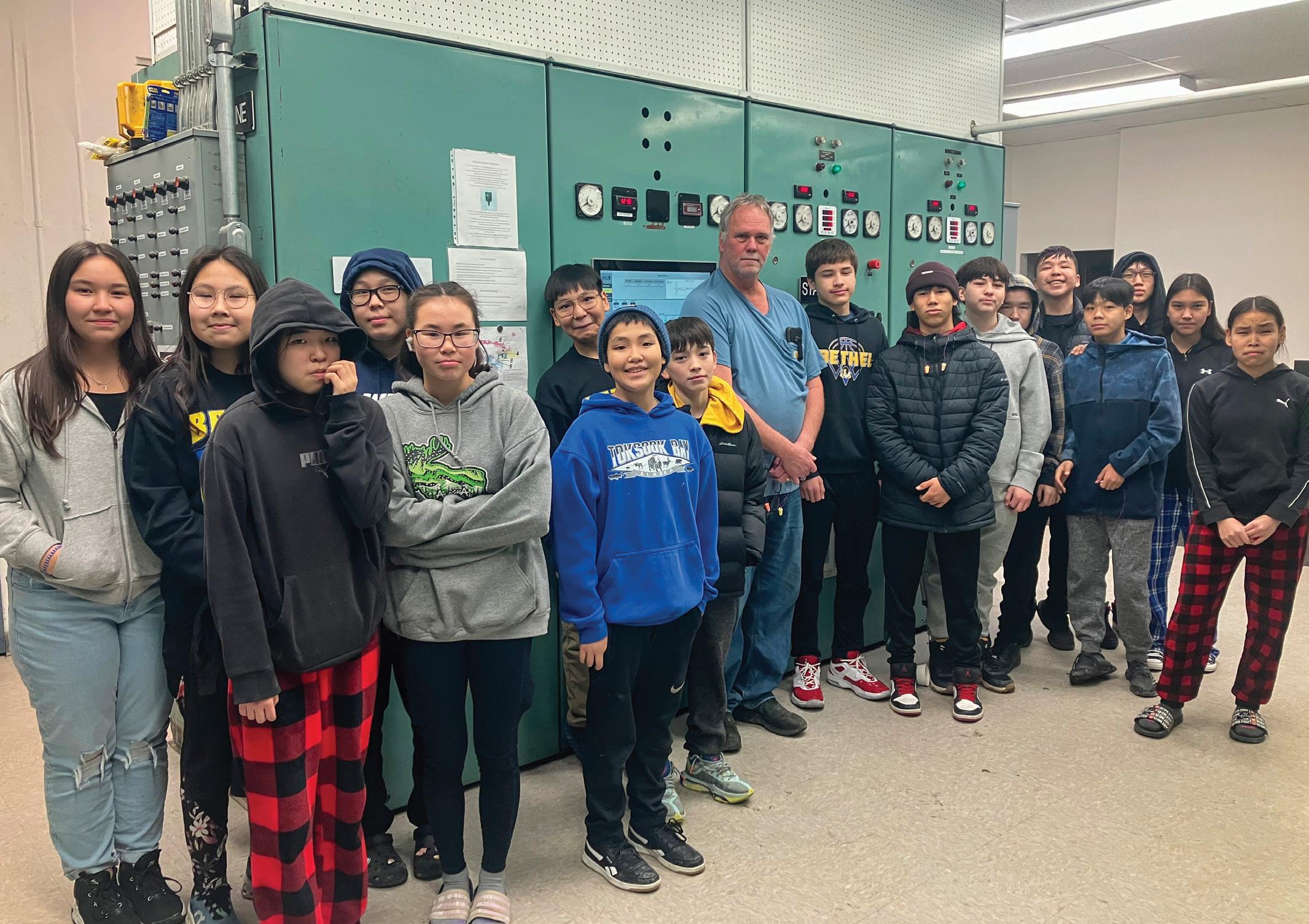


By Colleen Fisk, Renewable Energy Alaska Project Energy Education Director
More than 2,000 students from 90 fourth through 12th grade classrooms around the state participated in the 2024 Power Pledge Challenge, an initiative aimed at helping youth better understand energy use. Students competed for regional and statewide prizes
while learning about energy. An eighth grade science class from Bethel was the 2024 statewide winner.
Utilities and organizations from the Matanuska Susitna Valley, Anchorage, Kotzebue, Juneau, Fairbanks and Bering Strait hosted the challenge from August to November 2024. Students completed a hands-on activity from the AK EnergySmart curriculum, learned how to calculate the cost of appliance use and discovered ways

to reduce their energy use at home. Students then completed an online pledge of specific actions they would take to use energy more efficiently. Classes could also complete challenges to earn points toward more prizes, such as creating a community energy profile or interviewing someone who works in energy.
Mikaela Trowbridge’s fifth period science class at Bethel Regional High School is the 2024 statewide winner. The class received a pizza party and tour of the local power plant along with energy-related classroom materials worth $1,500. Five regional winners also earned a pizza party and/or tour of a local power plant.
“My students really enjoyed learning through the monthly challenges, extra lessons and guest speakers for the Power Pledge Challenge, and the friendly competition really gave them some buy-in for the material as well,” Mikaela says. “When my one class period beat the others in points, they were so proud of themselves. It really made them so excited, and they actually wanted to do more. Then, when they won in the state, they were extra proud of themselves and so excited for a field trip. I am so thankful for the opportunity to do this, get materials from this and take my kids on a trip I know they will remember.”
The 2024 winning classes are:
• Statewide Winner: Mikaela Trowbridge’s fifth period eighth graders at Bethel Regional High School.
• Anchorage Regional Winner: Afshan Mohammad’s sixth through eighth graders at Clark Middle School.
• Juneau Regional Winner: Angie Wright’s fifth graders at Auke Bay Elementary School.
• Mat-Su and Eagle River Regional Winner: Nickole Hamlin’s fourth and fifth graders at Glacier View School.
• Interior Regional Winner: Jenn Duncan’s fourth graders at Anne Wien Elementary School in Fairbanks.
• AVEC Winner: Florence Ingan’s sixth graders at Gladys Jung Elementary in Bethel.
• Bering Strait/Kawerak Regional Winner: Mark Jo Torrechiva’s high school students at Brevig Mission School.
The Power Pledge Challenge began in 2013, offering energy presentations to students in the Anchorage area. The now statewide initiative is held with support from Alaska Electric Light & Power, Alaska Energy Authority, Alaska Housing Finance Corporation, Alaska Village Electric Cooperative, Chugach Electric Association, Golden Valley Electric Association, Kawerak Inc., Kotzebue Electric Association, Matanuska Electric Association and Renewable Energy Alaska Project. n
For more information, or to get involved next semester, contact Renewable Energy Alaska Project Energy Education Director Colleen Fisk at education@realaska.org or 907-929-7770 ext. 3.





After seeing the photo we published in September of a fawn and cat, Ron Kopp decided to photograph similar events in his own backyard between a cat and a young buck.
“On our family ranch, south of Pilot Rock, Oregon, it is not unusual for deer to be in the yard—or cats, for that matter,” Ron says. “It is unusual for them to interact, however, especially on the sidewalk that leads to the ranch house’s front door.”
To submit your photo, email a JPEG file to photos@pioneer.coop. Include “Before You Go” in the subject line. Please share a bit about what inspired you to make your photo. n
A cat named Cat lies on a sidewalk as a curious buck leans down to lick it. As Cat placed his paw on the buck’s nose, neither seemed to mind the interaction. PHOTO COURTESY OF RON KOPP
Get more than 220 recipes in a perfect-bound 8½-by-11-inch indexed book for $10, postage included.



of cookbooks wanted, along with your name and address, to Ruralite Cookbooks, P.O. Box 1306, North Plains, OR 97133. BY PHONE: with Visa, MasterCard, Discover card or American Express. The 2008 contains recipes—most and dessert, the heartfelt stories recipes. indexed postage).



The 2008 contest cookbook contains more than 180 recipes—most with a side dish and dessert, too. Included are the heartfelt and entertaining stories that accompany the recipes. The 8½-by-11-inch indexed book is $8 (includes postage).
TO ORDER BY MAIL:
Submit payment with cookbook title, your name, address and number of cookbooks wanted to: Ruralite Cookbooks P.O. Box 1306 North Plains, OR 97133
TO PAY BY PHONE: Call 503-357-2105 for credit card payments with Visa, MasterCard, Discover or American Express.
TO ORDER ONLINE: Visit www.ruralite.com.
Please allow two to three weeks for delivery.
TO ORDER Submit your
cookbooks














Chair



Vice Chair
Helena Jones, Ambler

Fred Sagoonick, Shaktoolik


Secretary Sandra Lake, Hooper Bay
Treasurer Peter Demoski, Nulato
Directors
Homer Hunter Jr., Scammon Bay

Frederick P. Beans, Mountain Village Micheal Peters, Marshall board@avec.org
Communities Served
Alakanuk
Ambler
Andreafsky
Anvik
Bethel
Brevig Mission
Chevak
Eek
Ekwok Elim Emmonak
Gambell













Time is running out to be sure your community has a delegate at the AVEC Annual Meeting.














Goodnews Bay
Grayling
Holy Cross
Hooper Bay
Huslia
Kaltag
Kasigluk
Kiana
Kivalina
Kobuk
Kotlik
Koyuk


Nightmute Noatak Noorvik Nulato Nunapitchuk Old Harbor Oscarville Pilot Station Pitkas Point Quinhagak Russian Mission St. Mary’s St. Michael Savoonga

Lower Kalskag
Marshall Mekoryuk
Minto
Mt. Village
New Stuyahok

Scammon Bay Selawik Shageluk Shaktoolik Shishmaref Shungnak Stebbins Teller
Alaska Village Electric Cooperative, Inc.
4831 Eagle Street
Anchorage, AK 99503









907-561-1818



800-478-1818
www.avec.org


Togiak Toksook Bay Tununak Twin Hills Upper Kalskag Yakutat Wales /AlaskaVillage




Because AVEC serves 58 individual communities over such a broad area the Annual Meeting is really accomplished in two parts. One is a “mail-in” vote by all members to select directors for the board and to vote on proposed ballot measures. The second part is a gathering of delegates from every community served by AVEC to discuss AVEC issues and guide the goals of the cooperative.







Alakanuk Sandra Sage









Village Current Chairman Meeting Held (as of 1/20/2025)

Ambler Scott Jones 1/15/25
Anvik Sherry Kruger



























Bethel/Oscarville Marsha Riley Scheduled (2/05)
Brevig Mission Brian Crockett









Chevak Christine Symbol





Eek Teresa Ilutsik




Ekwok Crystal Jensen








Elim June Davis 12/16/24






Emmonak Lawrence Yupanik 11/23/24



Goodnews Bay Niall Bavilla


Gambell Deborah Apatiki 11/29/24

Grayling Ann Short



In order for community delegates to participate in the Annual Meeting, their community must have a local community meeting between November 1st and March 1. If your community has not held is AVEC Community Meeting yet this year, contact your community Chairperson or an AVEC Member Services Representative to be sure your meeting is scheduled. And please spread the word so quorum can be obtained!







Huslia Elsie Vent


























Every year at the Annual Meeting AVEC delegates learn more about their Cooperative and AVEC employees learn more about the communities and people we serve. It is a unique opportunity to highlight priorities, challenges and opportunities.

Every member who attends their community meeting will receive a $25 credit on their electric bill and have a chance to win an assortment of door prizes. Additional credits ranging from $50-$250 will be disbursed at the chairman’s discretion during the meeting and members will be entered to win a grand prize drawing for a $500 credit at the Annual Meeting.
In March, keep your eyes peeled for the ballots for mail-in voting. This year we will be providing the option to vote electronically or by mail. All votes must be received no later than April 16th, the day before the in-person Annual Meeting of the delegates in Anchorage on April 17, 2025.






We are looking forward to hearing from you, Bill Stamm
RIGHT: Community meetings must be completed before March 1, 2025.


















Kaltag Jacqueline Nicholas

Kasigluk Sam Tinker Sr
Kiana Lee A Barr Jr

Kivalina Brenda Hawley
Kobuk Eva Cleveland
Kotlik Victor Tonuchuk Jr
Koyuk Darin Douglas
Marshall Marvin Parent
Mekoryuk Samson Weston






Holy Cross Connie Walker 11/16/24


Minto Heather Roberts


Nightmute
Hooper Bay Virginia Hoelscher 11/9/24
New Stuyahok Gust Sr, Wassillie
Noatak Vincent Onalik Sr
Noorvik Lonnie Tebbits Sr
Nulato Peter Demoski
Nunapitchuk Henry Parks
Pilot Station Floyd Aleck
Pitkas Point Willaim Riley Jr
Quinhagak Joshua Cleveland
Russian Mission Patricia Pitka
Savoonga Bryan Rookok Jr
Scammon Bay Darlene Cholok
Selawik Clyde Ramoth
Shaktoolik Agnes Takak
Shungnak


Shishmaref Annie Weyiouanna
St. Mary's/Andreafsky Sven Paukan
St. Michael Timothy Snowball
Stebbins Nora Tom
Teller Sheila Baker
Togiak Daniel Gonzalez
Toksook Bay Paul Chimiugak
Tununak Susie Walter
Twin Hills Stella Mark
Upper Kalskag Isaac Stewart
Wales Gerald Oxereok




















Yakutat Ann Holcomb





Lower Kalskag Elia Sergie 11/15/24
Mt. Village Bibiana Sage 11/30/24
Old Harbor Phyllis Clough 12/28/24
Shageluk Harvey Benjamin 1/10/25































